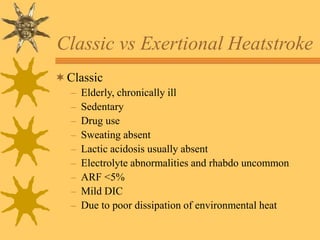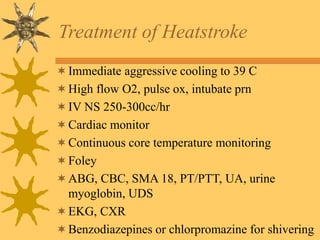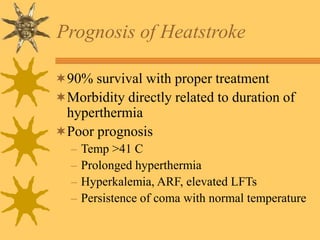11 b Heat Stroke ....,......m...mmm.....
- 1. Introduction Normal Body Temperature Regulation Causes of Heat Illness Clinical Pictures Treatment Prognosis Prevention
- 2. Body Temperature Regulation Heat Gain – Metabolic – Environmental Heat Loss – Radiation – Convection – Conduction – Evaporation
- 3. Heat Illness Predisposing Factors – Physical activity – Extremes of age, poor physical condition, fatigue – Excessive clothing – Dehydration – Cardiovascular disease – Skin disorders – Obesity – Drugs • Phenothiazines, anticholinergics, B and Ca channel blockers, diuretics, amphetamines, LSD, cocaine, MAOIs
- 4. Drugs that Interfere with Thermoregulation Increase heat production – Thyroid hormone – Amphetamines – TCAs – LSD Decrease thirst – Haldol Decrease sweating – Antihistamines – Anticholinergics – Phenothiazines – Benztropine
- 5. Pathophysiology of Heat Illness Heat Cramps Heat tetany Heat Exhaustion Heat Stroke – Heat stress – Loss of ability to sweat – Volume depletion and electrolyte imbalances not prominent – Pre-existing cardiovascular disease – End-organ damage
- 6. Heat Cramps Symptoms – Severe muscle cramps – General Weakness – Dizziness and fainting Treatment – Move to a cool shady place – Electrolyte drinks – Massage the cramped area – Apply moist towels to the cramped muscle and the patient’s forehead – Transport the person to a medical care facility if symptoms worsen
- 7. Heat Exhaustion Symptoms – Rapid and shallow breathing – Weak pulse – Cold and clammy skin – Heavy perspiration – Weakness and dizziness Treatment – Move to a cool shady place – Remove enough clothing to cool the patient – Fan the patient’s skin to promote sweat evaporation – If conscious provide electrolyte drinks – Treat for shock and transport to a medical care facility
- 8. Clinical Presentation Heat Stroke – True emergency – Altered LOC – Any neurologic finding – And elevated temperature – May still be sweating initially – Syncope – History is critical
- 9. Classic vs Exertional Heatstroke Classic – Elderly, chronically ill – Sedentary – Drug use – Sweating absent – Lactic acidosis usually absent – Electrolyte abnormalities and rhabdo uncommon – ARF <5% – Mild DIC – Due to poor dissipation of environmental heat
- 10. Classic vs Exertional Heatstroke Exertional – Men 15-45 years, healthy – Strenuous exercise – No drug use – Sweating often present – Lactic acidosis common – Frequent hyperkalemia, hypocalcemia, hypoglycemia – CPK markedly elevated, severe rhabdo – Hyperuricemia – ARF 25-30% – DIC marked
- 11. Differential Diagnosis of Heatstroke Malignant Hyperthermia – Halogenated anesthetics – Depolarizing muscle relaxants Febrile illness, especially CNS CVA Neuroleptic malignant syndrome and seizure Drug OD – Cocaine – Amphetamines, MDMA, MDEA
- 12. Heat Stroke Symptoms – Deep breathing becoming progressively more shallow – Rapid strong pulse becoming weaker – Dry and hot skin – Unconsciousness, seizures, and muscular twitching – Dilated pupils Treatment – Remove the person from any heat sources and remove clothing – Immerse the patient in cool water, or use cold wet towels or ice packs on the patient’s armpits, groin, under the neck, and behind the knees – Treat for shock and transport the patient to a medical care facility
- 13. Treatment of Heatstroke Immediate aggressive cooling to 39 C High flow O2, pulse ox, intubate prn IV NS 250-300cc/hr Cardiac monitor Continuous core temperature monitoring Foley ABG, CBC, SMA 18, PT/PTT, UA, urine myoglobin, UDS EKG, CXR Benzodiazepines or chlorpromazine for shivering
- 14. Heat Stress Prevention Drink plenty of water per day – 2 quarts minimum on mild days – 6 to 8 quarts on hot days or 1 quart an hour – Frequent sipping is better than guzzling Monitor the color of your urine Wear loose fitting and open clothing Do not overexert yourself Use the buddy system Don’t be afraid to stop, rest and drink
- 15. Prognosis of Heatstroke 90% survival with proper treatment Morbidity directly related to duration of hyperthermia Poor prognosis – Temp >41 C – Prolonged hyperthermia – Hyperkalemia, ARF, elevated LFTs – Persistence of coma with normal temperature
Editor's Notes
- 3
- 4
- 6
- 7
- 8
- 11
- 12
- 13
- 14
- 16
- There are several guides available on hydration requirements in relation to the amount of work done.
- 17














